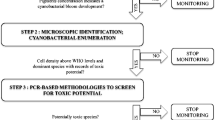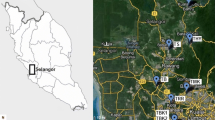Abstract
Cyanobacterial biomass, chlorophyll-a, and microcystin-LR levels were monitored in drinking and recreational water in Seoul, South Korea and three satellite cities from Oct 2006 to Aug 2007. Total microcystin-LR was the sum of particulate and dissolved microcystin. Except during cold periods, toxic cyanobacteria, including Anabaena flos-aquae, were found at all sites. The total microcystin-LR levels were below guideline danger levels (<1.0 μg/L) except one time (1.27 μg/L in October), whereas chl-a (111.7 μg/L) and cell levels (2.6 × 105 cells/mL) were at ‘vigilance’ and ‘alert’ levels for drinking water and at ‘guidance’ level for recreational water, respectively. Discrepancies in these parameters may thus lead to frequent unnecessary alerts, thereby increasing water management costs.




Similar content being viewed by others
References
APHA (1995) Standard methods for the examination of water and wastewater, 19th edn. The American Public Health Association, Washington, DC
Carmichael WW, Beasley VR, Bunner DL, Eloff JN, Falconer I, Gorham P, Harada KI, Krishanmurthy T, Yu MJ, Moore RE, Rinehart KL, Runnegar M, Skulberg OM, Watanabe MF (1988) Naming of heptapeptide toxins of cyanobacteria (blue-green algae). Toxicon 26:971–973
Chorus I (2005) Current approaches to cyanotoxin risk assessment, risk management and regulations in different countries. Federal Environment Agency, Berlin, pp 1–117
Domingos P, Rubim TKR, Molica JR, Azevedo SMFO, Carmichael WW (1999) First report of microcystin production by picoplanktonic cyanobacteria isolated from a Northeast Brazilian drinking water supply. Environ Toxicol 14:31–35
Figueiredo DR, Azeiteiro UM, Esteves SM, Goncalves FJM, Pereira MJ (2004) Microcystin-producing blooms-a serious global public health issue. Ecotoxicol Environ Safe 59:151–163
HC (2002) Guidelines for Canadian drinking water quality: supporting documentation—cyanobacterial toxins—microcystin-LR. Water Quality and Health Bureau, Healthy Environments and Consumer Safety Branch, Health Canada, Ontario
Hillebrand H, Dürselen CD, Kirschtel D, Pollingher U, Zohary T (1999) Biovolume calculation for pelagic and benthic microalgae. J Phycol 35:403–424
Hoeger SJ, Shaw G, Hitzfeld BC, Dietrich DR (2004) Occurrence and elimination of cyanobacterial toxins in two Australian drinking water treatment plants. Toxicon 43:639–649
Nagata S, Tsutusmi T, Hasegawa A, Yoshida F, Ueno Y, Watanabe MF (1997) Enzyme immunoassay for direct determination of microcystins in environmental water. J AOAC Int 80:408–417
NHMRC (2004) Australian drinking water guidelines. National Water Quality Management Strategy, National Health and Medical Research Council and the Natural Resource Management Ministerial Council, Canberra
SDI (2001) A study on the management of pond water quality in Seoul Municipal Parks. Seoul Development Institute, Seoul, pp 1–171
Teneva I, Asparuhova D, Dzhambazov B, Mladenov R, Schirmer K (2003) The freshwater cyanobacterium Lyngbya aerugineo-coerulea produces compounds toxic to mice and to mammalian and fish cells. Environ Toxicol 18:9–20
Vardaka E, Moustaka-Gouni M, Cook CM, Lanaras T (2005) Cyanobacterial blooms and water quality in Greek waterbodies. J Appl Phycol 17:391–401
WHO (1998) Cyanobacterial toxins: microcystin-LR. In: Guidelines for drinking water quality (ed) Addendum to vol. 2. Health criteria and other supporting information, 2nd edn. World Health Organization, Geneva, pp 95–110
WHO (2003) Algal and cyanobacteria in coastal and estuarine waters. In: Guidelines for safe recreational water environments, vol 1. Coastal and fresh waters. World Health Organization, Geneva, pp 136–158
Wood SA, Briggs LR, Sprosen J, Ruck JG, Wear RG, Holland PT, Bloxham M (2006) Changes in concentrations of microcystins in rainbow trout, freshwater mussels, and cyanobacteria in Lakes Rotoiti and Rotoehu. Environ Toxicol 21:205–222
Yasuno M, Sugaya Y, Kaya K, Watanabe M (1998) Variations in the toxicity of Microcystis species to Moina macrocopa. Phycol Res 46:31–36
Zavoruyev VV, Zotina TA (2003) A predominance of Lyngbya contorta Lemm. and the photosynthetic activity of phytoplankton in brackish water meromictic Lake Shira. Hydrobiol J 39:65–75
Acknowledgments
We wish to thank Dr. Suh MY for performing the microcystin measurements. This work was supported by the Daejin University Research Grants in 2010.
Author information
Authors and Affiliations
Corresponding authors
Rights and permissions
About this article
Cite this article
Kim, BH., Hwang, SJ., Park, MH. et al. Relationship Between Cyanobacterial Biomass and Total Microcystin-LR Levels in Drinking and Recreational Water. Bull Environ Contam Toxicol 85, 457–462 (2010). https://doi.org/10.1007/s00128-010-0121-y
Received:
Accepted:
Published:
Issue Date:
DOI: https://doi.org/10.1007/s00128-010-0121-y




